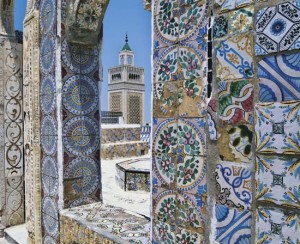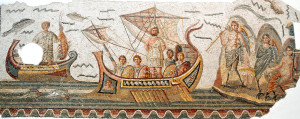…and ‘T’ is for tiles: the three ‘T’s that define the mosaic of Tunisia
The word ‘tile’ sounds a lot less artistic than ‘mosaic’.
But everywhere you go in Tunisia, it is the tiles you notice. Artistically arranged even if it’s just the one tile inset over the front door. Tiled steps. Faux archways carefully tiled with complex patterned squares reminiscent of Turkey’s Iznik pottery. An intricate sequence on a boundary wall.
 A restaurant sign in the beautiful village of Sidi Bou Said (see left).
A restaurant sign in the beautiful village of Sidi Bou Said (see left).
Sometimes, the tiles are arranged to form a mosaic, a snapshot of a scene from life as it once was. According to Tunisia’s tourism website, “sometimes, they would depict the urgency of a hunt, the wisdom-bestowing of a scholar, the actions of the ancient Roman gods and goddesses or the grandeur of a church. From the reverent to the bawdy, nearly every scenario of life found its way onto a mosaic piece.”
Tunisia’s tiles have a long history as is obvious from Nabeul, the town that has long been the centre of the country’s pottery industry. Nabeul is on the coast, in the northeast of the country, and was founded in the 5th century BC by the Greeks of Cyrene. Turkish influence has been strong. And then there are the Andalusian motifs and tile-making techniques, which were adopted by Tunisians after the 1609 expulsion of Muslims from Spain.
Green Prophet, which describes itself as “the voice for sustainable news in the Middle East”, writes, that “the final great exodus of Andalusian Muslims to Tunisia, that the application of enamel techniques revived the fading ceramic centers around the country.”
Tunis, the capital of Tunisia, rightly pays due heed to its traditional heritage of tilework. Back in May 2012, when tourists were still in short supply as a result of the chaos of the Arab Spring, the Bardo‘s spectacular new addition – a mosaic museum – opened. The Independent called it the “finest mosaic museum in the Mediterranean”, a magnificent collection of Roman and Byzantine scenes in ceramic chips, “undimmed by the two millennia since consuls and merchants indulged themselves in palaces across present-day Tunisia”.
Sadly now, nearly six months after the horrific attack on tourists at the Bardo, the ‘T’ that defines it in popular discourse may be terrorism rather than tilework.
Alas.
(Next: T is for tinned tuna though Tunisia has a long coast and lots of fresh fish)



